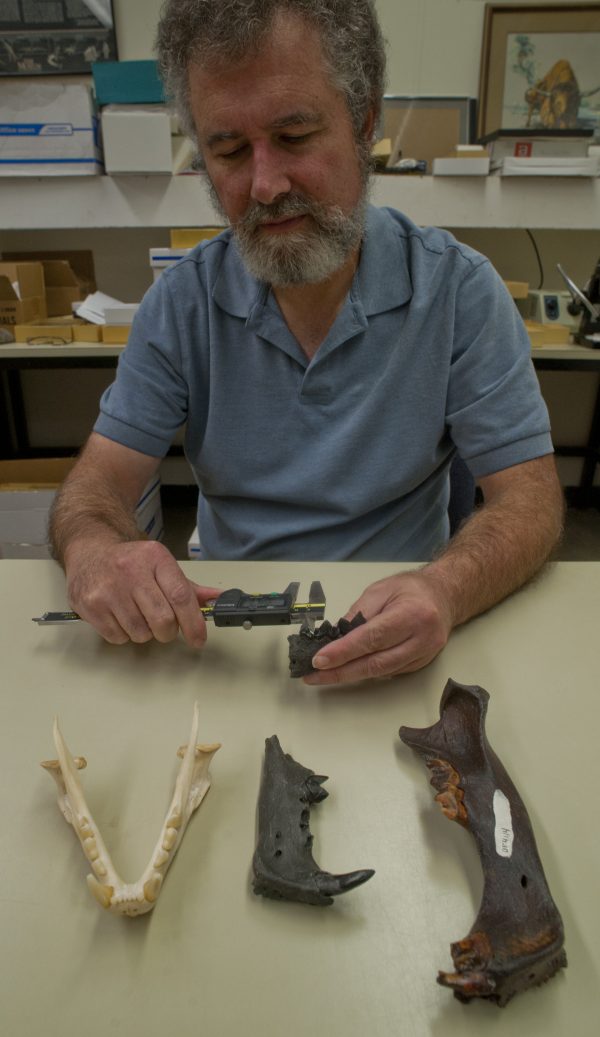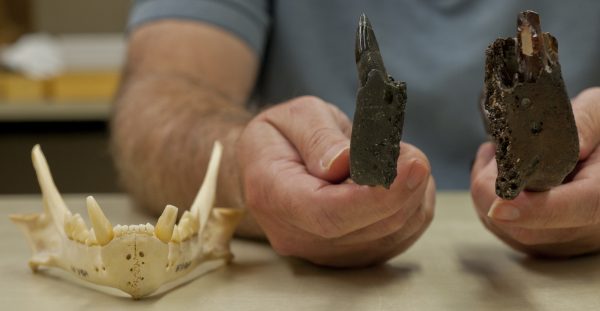
Florida Museum photo by Jeff Gage
After being stored in the Florida Museum of Natural History collections for 20 years, researchers have described a new genus and species of extinct saber-toothed cat from Polk County, Fla., based on additional fossil acquisitions.
When the animal was originally named in the 1980s, the study’s authors believed it was the oldest-known specimen in the genus Megantereon. The publication created controversy because analysis was only based on a partial lower jaw missing some critical features, said Florida Museum vertebrate paleontology collection manager Richard Hulbert Jr.
“It sort of raised some eyebrows from people in Europe and Africa because the species is known from the Old World and it’s actually fairly rare here in North America,” Hulbert said. “There were a number of papers back and forth, but things were not very well-settled.”
After Florida Museum paleontologists discovered more complete specimens from a phosphate mine in Polk County in 1990, Hulbert knew the animal had been incorrectly identified, he said.
“It’s a little odd that we’re publishing it now, 20 years later, but that’s sort of the way things go sometimes,” said Hulbert, who co-authored the study published in PLOS One March 14, 2013. “There are a lot of cool projects that just sit around in the museum cabinets waiting for the right person. These days, most people are pretty specialized and tend not to take the lead on something outside their specialty and so you just sort of wait until you find somebody you can collaborate with.”
Hulbert helped uncover fossils of the new genus and species, Rhizosmilodon fiteae, from the mine and later collaborated with the study’s lead author, Steven Wallace, an associate professor in the department of geosciences and member of the Don Sundquist Center of Excellence in Paleontology at East Tennessee State University.
“I spent two summers in Spain working at a locality that’s really rich in saber-toothed cats, which is sort of how I fell into the project,” Wallace said. “It was those trips to Spain that caught Richard’s attention. When I looked at the material there, I realized it was quite a bit different than the material in Florida.”
Wallace used comparative analysis of saber-toothed cat anatomy to help determine the 5-million-year-old fossils belong to the same lineage as the famous Smilodon fatalis from the La Brea Tar Pits in Los Angeles, a large, carnivorous apex predator with elongated upper canine teeth. Rhizosmilodon fiteae is the sister taxon to Megantereon and Smilodon, and the oldest of the group.
“It’s a really cool example of what we call parallel evolution, when two closely related animals evolve in different places but they look very similar because they’re doing the same thing,” Wallace said.
Analysis was primarily based on the structure of the animal’s lower jaw and teeth, which are smaller than the Smilodon, about the size of a modern Florida panther. These three cats are in the same tribe – meaning they are more closely related than a family or subfamily – and are often collectively referred to as saber-toothed cats because of their long canine teeth, Hulbert said.
“When people think of saber-toothed cats, they think of it as just one thing, as if the famous tar pit saber-toothed cat was the only species, when in fact, it was an almost worldwide radiation of cats that lasted over 10 million years and probably had a total of about 20 valid species,” Hulbert said. “Counting the newly described animal, there are now six different species of saber-toothed cats known just from Florida.”

Florida Museum photo by Jeff Gage
Previous research suggested the group of saber-toothed cats known as Smilodontini originated in the Old World and later migrated to North America, but the age of the new species indicates the group likely originated in North America.
“Smilodon first shows up on the fossil record around 2.5 million years ago, but there haven’t been a lot of good intermediate forms for understanding where it came from,” Hulbert said. “The new taxon shows that the most famous saber-toothed cat, Smilodon, had a New World origin and it and its ancestors lived in the southeastern U.S. for at least 5 million years before their extinction about 11,000 years ago. Compared to what we knew about these earlier saber-toothed cats 20 or 30 years ago, we now have a much better understanding of this group.”
The species was named after Barbara Fite of Lutz, Fla., who donated one of the critical specimens and allowed University of Florida scientists to make casts of two other partial jaws in her collection. The donation was a major contribution to the research because the remarkably well-preserved lower jaw contains almost pristine examples of all three chewing teeth, Hulbert said. The genus name Rhizosmilodon, meaning “root of Smilodon,” derives from its inferred ancestral relationship with Smilodon, which became extinct about 11,000 years ago.
Hulbert describes the new species as an “evolutionary mosaic,” because it shares a mixture of primitive and specialized characteristics.
Saber-toothed cat expert Julie Meachen, an instructor at Marshall University School of Medicine in Huntington, W. Va., said the study helps settle the debate about whether the tribe arose from Eurasia before coming to North America.
“I think that this revision was well-needed,” Meachen said. “The fact that it’s one of the oldest lineages is really interesting because that means that this exciting group of saber-toothed cats really is a North American tribe – it evolved and persisted in North America.”
Since 1915, more than 60 new species of reptiles, birds and mammals have been named from Central Florida phosphate mines, located southeast of Tampa and south of Lakeland. Rhizosmilodon lived in a forested coastal habitat that was also home to rhinos, tapirs, three-toed horses, peccaries, llamas and deer. Its relatively small size probably allowed it to climb trees and to safely hide captured prey away from large carnivores, such as packs of wolf-sized hyena-dogs and an extinct type of bear larger than the modern grizzly.
For more information about Rhizosmilodon.
Read the full study in PLOS One
Learn more about the Vertebrate Paleontology Collection at the Florida Museum.